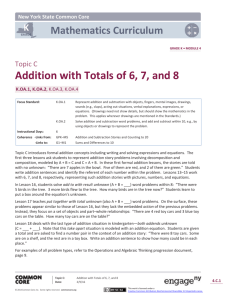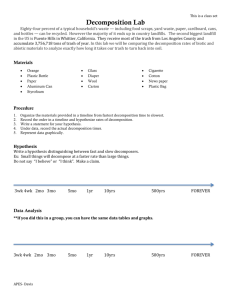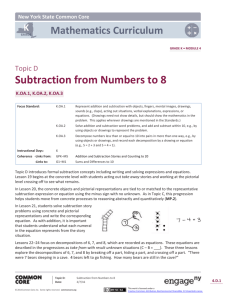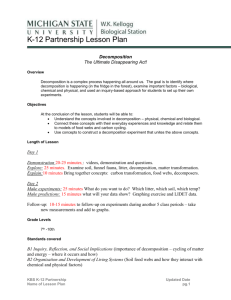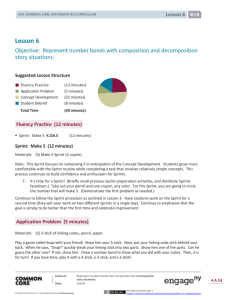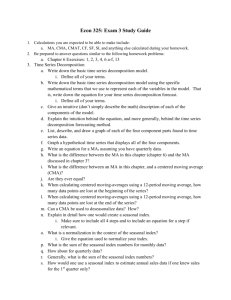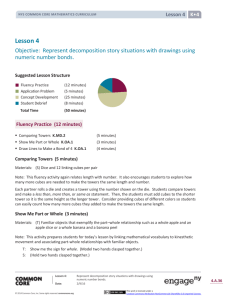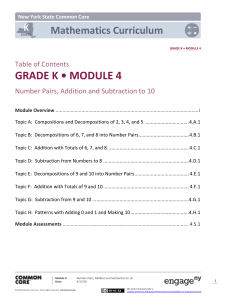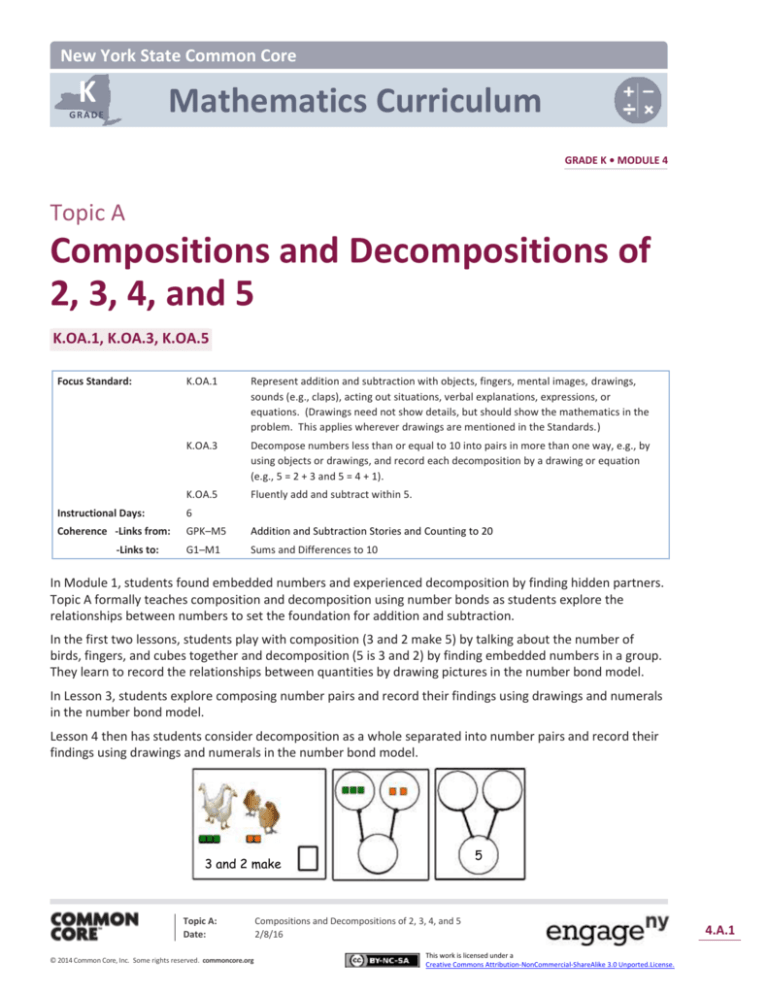
New York State Common Core
K
X
Mathematics Curriculum
GRADE
GRADE K • MODULE 4
Topic A
Compositions and Decompositions of
2, 3, 4, and 5
K.OA.1, K.OA.3, K.OA.5
Focus Standard:
K.OA.1
Represent addition and subtraction with objects, fingers, mental images, drawings,
sounds (e.g., claps), acting out situations, verbal explanations, expressions, or
equations. (Drawings need not show details, but should show the mathematics in the
problem. This applies wherever drawings are mentioned in the Standards.)
K.OA.3
Decompose numbers less than or equal to 10 into pairs in more than one way, e.g., by
using objects or drawings, and record each decomposition by a drawing or equation
(e.g., 5 = 2 + 3 and 5 = 4 + 1).
K.OA.5
Fluently add and subtract within 5.
Instructional Days:
6
Coherence -Links from:
GPK–M5
Addition and Subtraction Stories and Counting to 20
G1–M1
Sums and Differences to 10
-Links to:
In Module 1, students found embedded numbers and experienced decomposition by finding hidden partners.
Topic A formally teaches composition and decomposition using number bonds as students explore the
relationships between numbers to set the foundation for addition and subtraction.
In the first two lessons, students play with composition (3 and 2 make 5) by talking about the number of
birds, fingers, and cubes together and decomposition (5 is 3 and 2) by finding embedded numbers in a group.
They learn to record the relationships between quantities by drawing pictures in the number bond model.
In Lesson 3, students explore composing number pairs and record their findings using drawings and numerals
in the number bond model.
Lesson 4 then has students consider decomposition as a whole separated into number pairs and record their
findings using drawings and numerals in the number bond model.
5
3 and 2 make
Topic A:
Date:
© 2014 Common Core, Inc. Some rights reserved. commoncore.org
Compositions and Decompositions of 2, 3, 4, and 5
2/8/16
This work is licensed under a
Creative Commons Attribution-NonCommercial-ShareAlike 3.0 Unported.License.
4.A.1
Topic A K
NYS COMMON CORE MATHEMATICS CURRICULUM
Lesson 5 allows students to use the number bond model as a tool to help them model composition and
decomposition. The end goal of this topic is for students to be flexible with the number bond model oriented
in various ways and to be able to understand the part–part–whole components. By the end of the module,
students understand the number bond’s relationship to the accompanying expression or equation.
3
5
2
3
3
5
2
5 = ____ + ____
3 + 2 = ____
2 + 3 = ____
5 – 3 = _____
The final lesson of the topic gives students opportunities to move from the abstract to the concrete by acting
out and creating stories based on a given number bond. Throughout Topic A, a fluid movement between
composition and decomposition provides a firm foundation for understanding the relationship between
addition and subtraction.
A Teaching Sequence Toward Mastery of Compositions and Decompositions of 2, 3, 4, and 5
Objective 1: Model composition and decomposition of numbers to 5 using actions, objects, and
drawings.
(Lesson 1)
Objective 2: Model composition and decomposition of numbers to 5 using fingers and linking cube
sticks.
(Lesson 2)
Objective 3: Represent composition story situations with drawings using numeric number bonds.
(Lesson 3)
Objective 4: Represent decomposition story situations with drawings using numeric number bonds.
(Lesson 4)
Objective 5: Represent composition and decomposition of numbers to 5 using pictorial and numeric
number bonds.
(Lesson 5)
Objective 6: Represent number bonds with composition and decomposition story situations.
(Lesson 6)
Topic A:
Date:
© 2014 Common Core, Inc. Some rights reserved. commoncore.org
Compositions and Decompositions of 2, 3, 4, and 5
2/8/16
This work is licensed under a
Creative Commons Attribution-NonCommercial-ShareAlike 3.0 Unported.License.
4.A.2

